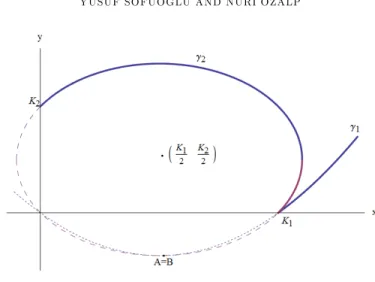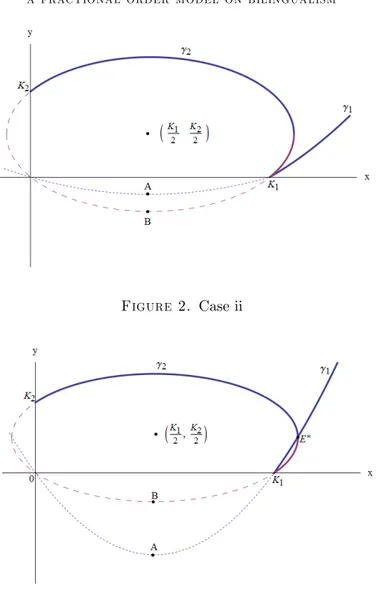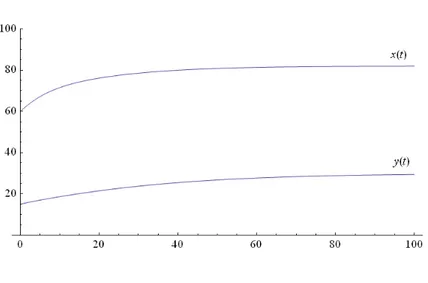IS S N 1 3 0 3 –5 9 9 1
A FRACTIONAL ORDER MODEL ON BILINGUALISM
YUSUF SOFUOGLU AND NURI OZALP
Abstract. A fractional order model of one unilingual component and one bilingual component of a population is developed. Equilibrium points are found and their stability is investigated. Also, numerical solutions are obtained for an example of the system.
1. Introduction
Models for the growth of a population with one unilingual and one bilingual component are developed by Baggs and Freedman in which the models consist of a system of two ordinary di¤erential equations are studied. In the Baggs-Freedman model and in most of the work following them, integer order di¤erential equations has been used [1].
In recent years, it has turned out that many phenomena in di¤erent …elds can be described very succesfully by the models using fractional order di¤erential equations [2].The derivative of an arbitrary order or fractional derivative has been introduced almost 300 years ago with a query posed by L’Hospital to Leibnitz. The fractional calculus was reasonably developed by 19th century. It was realized, only in the past few decades that these derivatives are better models to study physical phenomenon in transient state [3]. Also using fractional order di¤erential equations can help us reduce the errors arising from the neglected parameters in modelling real life phenomena [4]. These are some of the reasons that motivate us to use fractional order model instead of integer order one.
In this paper, we will develop a fractional order model of one unilingual com-ponent and one bilingual comcom-ponent of a population and we will investigate the dynamics of the interactions of the population in a closed environment and we apply and get the numerical results of the model to the bilingual population of Turkey.
Received by the editors June 13, 2014; Accepted: Oct. 24, 2014. 2010 Mathematics Subject Classi…cation. 23A33, 26A33, 34A99. Key words and phrases. Fractional di¤erential equations, bilingualism.
c 2 0 1 4 A n ka ra U n ive rsity
2. Modelling
First, we need to recall the de…nition of fractional order derivative. Altough there are several de…nitions of fractional order derivatives and integrals, we use Caputo’s de…nition in this paper. The main advantage of Caputo’s de…nition is that the initial conditions for fractional di¤erential equations with Caputo derivatives are in the same form as for integer-order di¤erential equations [3].
De…nition 2.1. The Caputo-type fractional derivative of order q > 0 for a function f : (0; 1) ! R is de…ned by Dqf (t) = 1 (n q) Z t 0 (t )n q 1f(n)( )d ; where n = bqc + 1 and bqc is the integer part of q.
Here and elsewhere denotes the gamma function.
Alongside of Turkish speaking unilingual majority in Turkey, there are several bilingual groups which speak one of the languages such as Kurdish, Arabic, Lazish etc., as their mother tongue together with Turkish. In our model, the population which speaks only Turkish is considered as unilingual component and the popula-tion which also speaks mother tongue is considered as bilingual component. The interaction between these two components is given by an autonomous system which consists of two di¤erential equations of fractional order. The concentrations of the components at time t 0 are represented by x(t) and y(t); respectively.
As being the situation in Turkey, since the movement is assumed to be in steady-state, the e¤ect of the emigration from the environment and immigration to the environment are not considered. We also assume that conversion from unilingual to bilingual doesn’t exist. In addition, we assume that children born to bilingual par-ents may enter the population as bilinguals or unilinguals, but children of unilingual parents enter the population as unilinguals.
Considering all these assumptions, we can write Dqx(t) = (B
1 D1)x(t) L1x2(t) + P1B2y(t)
Dqy(t) = (P
2B2 D2)y(t) L2y2(t)
(2) where 0 < q 1; Bi > Di (i = 1; 2); 0 < P1 < 1 and P2 = 1 P1. P1 represents
the rate of the children of y, which enter the population as unilinguals. Also, B1
and D1+ L1x are, respectively, the speci…c birth rate and death rate of x, while
similarly B1and D1+L1x are of y. Carrying capasities of the environment of x and
y will be denoted by K1 and K2, respectively, where K1=B1L1D1 , K2= B2L2D2:
3. Stability of the System
Setting Dqx(t) = 0 and Dqy(t) = 0; we have Dqx(t) + Dqy(t) = 0. We …nd the
equilibrium points by intersecting the curves that represent these equations. De-noting the curves given by the …rst and the third equailities by 1, 2, respectively,
we get 1 : y = x P1B2 [L1x (B1 D1)] 2 : L1 x B1 D1 2L1 2 + L2 y B2 D2 2L2 2 =(B1 D1) 4L1 2 +(B2 D2) 4L2 2 :
1 is a parabola passing through the points (0; 0) and (K1; 0), while 2 is an
el-lipse with centre at (K1
2 ;
K2
2 ); passing through the points (0; 0), (K1; 0); (0; K1)
and (K1; K2) etc. Thus the equilibrium points with nonnegative components are
E0(0; 0), E1(K1; 0) and E 12K1+12 q K2 1+ 4P1B2(P2B2 D2) L1L2 ; P2B2 D2 L2 :
The Jacobian matrix J (x ; y ) for the system given in (2) is J (x ; y ) = B1 D1 2L1x P1B2
0 P2B2 D2 2L2y
: The Jacobian matrix at E0 is
J (E0) = J (0; 0) = B1 D1 P1B2
0 P2B2 D2 :
We know that, if all of the eigenvalues, i (i = 1; 2) of J (E0) satisty the condition
jarg ij > q2 , then E0 is asymptotically stable [5],[6]. Solving the characteristic
equation det(J (E0) I) = 0, we obtain the equation (B1 D1 )(P2B2 D2 ) =
0; which has the roots 1= B1 D1 and 2= P2B2 D2. Since we assume that
B1 D1> 0, E0is unstable. Following the same procedure as in the investigation
of stability for E0, we get the Jacobian matrix at E1 as
J (E1) =
(B1 D1) P1B2
0 P2B2 D2
and the eigenvalues of the characteristic equation det(J (E1) I) = 0 as 1 =
(B1 D1) and 2 = P2B2 D2. Since 1 = (B1 D1) < 0, the condition
that makes E1 asymptotically stable can be de…ned as 2= P2B2 D2 < 0. But
the points E0(0; 0) and E1(K1; 0) are of little interests, since the …rst one means
that there is no population and the second one means that there is no bilingual population. Thus we are interested in analysing the equilibrium point E which has positive components.
Now, we investigate the existence, uniqueness and stability for E . Theorem 3.1. If L1K21 4B2P1 < K2 2 1 2 q L1K12+L2K22
L2 , then E exists and is unique. If L1K12 4B2P1 K2 2 1 2 q L1K21+L2K22
L2 , then E doesn’t exist.
Proof. The vertex of the parabola 1is A(K1
2 ;
L1K12
4B2P1) and the image of x = K1 2 on the ellipse 2 is B(K1 2 ; K2 2 1 2 q L1K12+L2K22
Figure 1. Case i of the relationship betweeen the points A and B.
Case i) A = B. In this case, the second component of each point must equal, i.e., L1K12 4B2P1 = K2 2 1 2 q L1K12+L2K22
L2 : Thus, the only nonnegative point where the
curves 1and 2 intersect is (K1; 0) (see Figure 1). Since we try to …nd an
equi-librium E which has nonnegative components and since the second component of (K1; 0) is not positive, E doesn’t exist.
Case ii) The point A is above B. In this case L1K12 4B2P1 > K2 2 1 2 q L1K12+L2K22 L2 holds
and as in the Case i, E doesn’t exist (see Figure 2). Case iii) The point A is below B. That is L1K12
4B2P1 < K2 2 1 2 q L1K21+L2K22 L2 . In this
case E exists and is unique (see Figure 3).
Theorem 3.2. If P2B2 D2> 0, then E is asymptotically stable.
Proof. The Jacobian matrix at E is J (E ) = " L1 q K2 1+ 4P1B2(P2B2 D2) L1L2 P1B2 0 (P2B2 D2) #
and the roots of the characteristic equation det(J (E ) I) = 0 are 1 = L1
q K2
1+
4P1B2(P2B2 D2)
Figure 2. Case ii
Figure 3. Case iii
since P2B2 D2> 0. Therefore, E is asymptotically stable.
4. Simulation
The following two theorems, which are given in [7], will be used for …nding the solution of fractional di¤erential system.
Theorem 4.1. Let k:k denote any convenient norm on Rn: Assume that f 2
C [R1; Rn] ; where R1= [(t; X) : 0 t a and kX X0k b] ; f = (f1; f2; :::; fn)T;
and X = (x1; x2; :::; xn)T; and let kf(t; X)k M on R1: Then there exists at least
one solution for the system of fractional di¤ erential equation given by
DqX(t) = f (t; X(t)) (3)
with the initial condition
X(0) = X0 (4)
on 0 t ; where = min(a; b
M (q + 1) 1=q
); 0 < q < 1:
Theorem 4.2. Consider IVP given by (3)-(4) of order q (0 < q < 1). Let g(v; X (v)) = f (t (tq v (q + 1))1=q; X(t (tq v (q + 1))1=q)) and assume
that the condition of Theorem 4.1 hold. Then a solution X(t) of Dqx(t) = f (t; x(t))
x(0) = x0
can be given by X(t) = X (tq= (q + 1)); where X (v) is a solution of the system of integer order di¤ eretial equations
d(X (v))
dv = g (v; X (v)) with the initial condition
X (0) = X0:
Substituting B1 = 0:14; B2 = 0:2; D1 = D2 = 0:02; P1 = 0:6; P2 = 0:4;
L1= L2= 0:002; which are expected values for Turkey, and q = 0:9 in system (2),
we obtain
D0:9x = 0:12x 0:002x2+ 0:12y (5)
D0:9y = 0:06y 0:002y2
and the positive equilibrium point is E (81:9615; 30): Letting the initial conditions
x(0) = 60; y(0) = 15 (6)
and using Theorem 4.2 to solve IVP (5)-(6), the corresponding integer order system becomes dx (v) dv = 0:12x (v) 0:002x 2(v) + 0:12y (v) (7) dy (v) dv = 0:06y (v) 0:002y 2(v)
with the initial conditions
Figure 4. Solutions x and y of the system (5)-(6)
Since we have transformed the fractional order system (5)-(6) into the integer order system (7)-(8), we can apply any convenient method improved for …nding solution of integer order systems. The second equation in system (7) is a seperable …rst order di¤erential equation and its solution with the initial condition y (0) = 15 can easily be found as
y (v) = 0:9e
0:06v
0:03 + 0:03e0:06v: (9)
Substituting y (v) in the …rst equation of system (7), we have dx (v)
dv = 0:12x (v) 0:002x
2(v) + 3:6e0:06v
1 + e0:06v: (10)
We apply the Adams-Bashforth-Moulton method to get the numerical solution of the integer order di¤erential equation (10) with the initial condition x (0) = 60; and then we take v = t0:9= (1:9), both in (9) and (10), to turn back to the fractional order system (5)-(6) according to Theorem 4.2. It means that the solution (x (v); y (v)) of the integer order system corresponds the solution (x (t0:9= (1:9)); y (t0:9= (1:9))) of the fractional order system (5)-(6). Therefore,
we obtain the solution of the fractional order system (5)-(6) as shown in Figure 4. It is seen in this …gure that x(t) and y(t) approximate to points 81:9615 and 30, respectively, which are the components of positive equilibrium E . It means that, under the assumptions which construct the model, unilingual and bilingual popu-lations in Turkey (along with expected values) are steady-state at points 81:9615 and 30 (in millions).
We also solve the system (5)-(6), directly by using the method given in [8]. The method is a predictor-corrector type numerical method to solve fractional order
initial value problems of the form (3)-(4). A statement in a pseudo-code notation for the algorithm, in which necessary changes are made to adapt our system, is as follows. h := T =N m := dqe FOR k := 1 TO N DO BEGIN bk := kq (k 1)q ak:= (k + 1)q 2kq+1+ (k 1)q+1 END FOR j := 1 TO N DO BEGIN p1:= x0+ h q (q+1) j 1 X k1=0 bj k1 f1(xk1; yk1) p2:= y0+ h q (q+1) j 1 X k2=0 bj k2 f2(xk2; yk2) xj := x0+ h q (q+1) f1(p1; p2) + (j 1) q+1 (j 1 q)jq f 1(x0; y0) + j X k=1 aj k+1f1(xk; yk) ! yj := y0+ h q (q+1) f2(p1; p2) + (j 1) q+1 (j 1 q)jq f 2(x0; y0) + j X k=1 aj k+1f2(xk; yk) ! END
Here T is the upper bound of the interval where the solution is to be approxi-mated and N is the number of time steps that the algorithm is to take. Both T and N are positive integers and fi (i = 1; 2) is the right-hand side of the ith equation
of the system (5). In a programming language of our preference, the method is applied to the system and the result is shown in Figure 4.
References
[1] I. Baggs, H.I. Freedman, A mathematical model for the dynamical interactions between a unilingual and bilingual population: persistence versus extinction, J. Math. Sociol. 16 (1990) 51–75.
[2] H. Xu, Analytical approximations for a population growth model with fractional order, Com-munications in Nonlinear Sciense and Numerical Simulation 14 (2009) 1978-1983.
[3] I. Podlubny, Fractional Di¤erential Equations, Academic Press, San Diego, 1999.
[4] N. Özalp, E. Demirci, A fractional order SEIR model with vertical transmission, Mathematical and Computer Modelling 54 (2011) 1-6.
[5] E. Ahmed, A.M.A. El-Sayed, H.A.A. El-Saka, Equilibrium points, stability and numerical so-lutions of fractional-order predator-prey and rabies models, Journal of Mathematical Analysis and Applications 325(2007) 542-553.
[6] D. Matignon, Stability results for fractional di¤erential equations with applications to control processing. In:Computational Eng. in Sys. Appl., vol. 2. Lille, France, p. 963, 1996.
[7] E. Demirci, N. Özalp, A method for solving di¤erential equations of fractional order, Journal of Computational and Applied Mathematics 236 (2012) 2754-2762.
[8] K. Diethelm, J.F. Neville, D.F. Alan, A predictor-corrector approach for the numerical solution of fractional di¤erential equations, Nonlinear Dynamics 29 (2002) 3-22.
Current address : Ankara University, Faculty of Sciences, Department of Mathematics,06100 Besevler, Ankara, Turkey
E-mail address : ysofuoglu@ankara.edu.tr
Current address : Ankara University, Faculty of Sciences, Department of Mathematics,06100 Besevler, Ankara, Turkey


